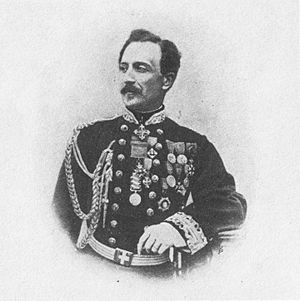Giuseppe Govone facts for kids
Giuseppe Govone (born in Isola d'Asti, 1825 – died in Alba, Italy, January 1872) was an Italian general and politician. He was from the Piedmont region of Italy. Govone played a very important part in the Risorgimento, which was the movement to unite Italy into one country. He was a skilled officer who fought in three major wars that helped create modern Italy. Later, he became the Minister of War in the government led by Giovanni Lanza.
Contents
Early Military Career
Fighting for Italian Independence
Giuseppe Govone began his military career as a young officer. He was a First Lieutenant and fought in important battles like Pastrengo, Peschiera, and Cerlungo. These battles were part of the First Italian War of Independence (1848-1849).
After these battles, he was promoted to captain. He then joined the team of General Alfonso La Marmora. In 1849, Govone helped put down a rebellion in Genoa. This rebellion happened after a peace agreement with Austria. Govone managed to take control of three forts near Genoa without a fight. For his brave actions in this war, he received two Silver medals.
The Crimean War Experience
Govone also played a key role in the Crimean War (1853–1856). This war involved Russia, Turkey, and other European powers. As a captain, he helped defend the city of Silistria in 1854. He designed a new fort inside the city, which stopped the Russian army from capturing it right away.
Later, he was promoted to major. He even took part in the famous Charge of the Light Brigade on October 25, 1854. This was a well-known cavalry charge during the Battle of Balaclava.
Second Italian War of Independence
Before the Second Italian War of Independence began in 1859, Govone was promoted to lieutenant colonel. He worked at the King's main headquarters. He was also put in charge of military intelligence, which meant gathering secret information.
In this role, Govone often went behind enemy lines to gather information from the Austrian army. He also fought bravely in major battles such as Battle of Palestro, Battle of Magenta, and Battle of San Martino. These battles were crucial for Italy's unification.
Keeping Order in Southern Italy
Fighting Brigandage in the South
After the Second War of Independence, Govone was promoted to colonel at just 33 years old. He was sent to southern Italy to deal with a problem called "brigandage." This was a period when many groups of armed people, sometimes called bandits or rebels, resisted the new unified Kingdom of Italy.
Govone worked in the Roveto and Liri valleys. He fought against a famous brigand named Chiavone. This was a very tough fight, but Govone tried to avoid unnecessary cruelty. He captured a Spanish general named José Borjes, who was helping the rebels. Borjes was later executed. Chiavone was eventually sentenced to death by his own lieutenants.
Challenges in Sicily
In 1861, Govone was promoted to brigadier general and moved to Sicily in 1862. Here, he faced a big problem: many young men were trying to avoid joining the army. He used strong measures to stop this, especially in western Sicily.
Under a law called the Pica Act (Legge Pica) from 1863, Govone put the area under military rule. He brought in many soldiers from the elite Bersaglieri corps. He saw groups like the mafia as rebels against the new Italian government. His troops would surround towns, cut off water, and sometimes take relatives of suspected draft dodgers as hostages.
This was a very difficult time. Govone faced strong opposition from some powerful Sicilian families and rising middle-class groups. They accused him of harsh actions. Govone defended himself, describing the challenges of dealing with the situation in Sicily. This led to a big debate in the Italian parliament. He was cleared of the accusations and promoted to major general. However, he was moved back to the mainland.
Honors and Recognition
Giuseppe Govone received many awards for his service and bravery. These included:
- Silver Medals for Military Valor for his actions in Cerlungo (1848) and Genoa (1849).
- Officer of the Military Order of Savoy for his role in the Second War of Independence (1859).
- Grand Officer of the Military Order of Savoy for his service in the Third War of Independence (1866).
- Grand Officer of the Order of Saints Maurice and Lazarus.
- Knight of the Order of the Medjidie for his service in the Danube Campaign (1854).
- Knight of The Most Honourable Order of the Bath for his part in the Battle of Balaclava (1854).
- Officer of the Ordre national de la Légion d'honneur for his actions in the Battle of Chernaya River (1855).
- British Crimea Commemorative Medal with three clasps for Balaclava, Inkerman, and Sevastopol (1855).
- Turkish Crimea Commemorative Medal.
See also
- Brigandage in the Two Sicilies
- Royal Italian Army
Images for kids



